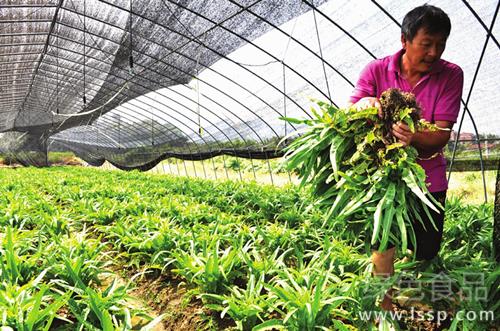The weak seedling condition is caused by many factors, how to manage winter wheat symptomatically.
1. Soil drought: in wheat fields where the soil moisture is insufficient or ventilated, the tillers are born slowly, the leaves are gray-green, the heart leaves are short, the growth is slow or stagnant (also known as "shrinking seedlings"), the middle and lower leaves of wheat gradually turn yellow and dry, and the roots are few and thin. Key points of management: combined with watering, 15 kg ammonium bicarbonate per mu.

Wheat seedling condition
two。 Soil nitrogen deficiency: the seedlings were thin and erect, the tillers decreased, the leaves were narrow and short, and the lower leaves of wheat gradually turned yellow and withered from the leaf tip and spread to the upper leaves. Key points of management: urea 7kg / mu, or ammonium bicarbonate 20kg / mu, furrow application or watering.
3. Soil phosphorus deficiency: the root system of weak wheat seedlings is poor, the secondary roots are few and weak, the leaves are dark green and dull, the leaf tips and leaf sheaths are purplish red, the plants are thin and small, and the tillers are reduced. Key points of management: combined with watering and hoeing, 20-30 kg superphosphate per mu, furrow application between rows.
4. Soil wet plate or saline-alkali: the root system of wheat seedlings is poor, the absorptive capacity is weak, the tiller is born slowly, accompanied by defatting disease; if the saline-alkali harm is serious, there are purplish red "little old seedlings", and 1 or 2 leaves at the base of the seedlings yellowed and withered, when serious, the seedlings withered. Key points of management: combined with deep ploughing, ditching and topdressing nitrogen and phosphorus mixed fertilizer; if the harm of salinity is serious, after topdressing, irrigate water and press salt, and cut hoe to loosen the soil to break the consolidation.
5. The soil plate is hard: lack of soil moisture and less air, and it is difficult for the root system to stretch, so that the wheat leaves are yellow and short, and the tillers can not appear on time. Key points of management: first timely watering, and then deep ploughing and loosening soil to break the rigid layer.
6. The soil is too wet: the weak seedling leaves are lavender, the tillers are born slowly, and when serious, the leaf tips become white and dry. Key points of management: first deep ploughing in time, dispersing moisture and aeration, and then topdressing a small amount of available fertilizer to promote the early development of seedlings.
7. The sowing rate is too large: the seedlings are crowded and the plants are thin and slender. Key points of management: first, we should pay close attention to the thinning of seedlings, especially the "pimple seedlings" in the land, the edge of the ground, and the fields, and then combine with watering and apply a small amount of nitrogen and phosphorus fertilizer to make up for the nutrients consumed excessively by the soil and promote the wheat seedlings to change from weak to strong.
8. Sowing too deep: slow emergence, slender leaf sheath, no tillering, no long rooting. Key points of management: first pick the soil and clear the trees, and then topdressing in time (15kg ammonium bicarbonate per mu) to promote the root system and seedling development of wheat seedlings.
9. Shallow sowing: the tiller node of the weak seedling is close to the ground, the water nutrient is poor, the root growth and tiller bud development are inhibited, due to the reduction of roots and tillers, the plant is yellow and weak, easy to die by freezing. Management points: combined with hoe, soil around the root; when the growth of wheat aboveground is suspended, break the ridge to cover the soil. The thickness of soil cover is suitable to make the tillering node below the surface about 3cm; if covered with guest soil, that is, cover sand with clay and cover with sand, the soil can also be improved.
10. Sowing too late: due to the short growth period and insufficient accumulated temperature before winter, wheat grows thin and has few tillers. Key points of management: mainly to paddle hoe and replenish fertilizer and water, 15kg ammonium bicarbonate per mu is applied in the three-leaf period; in wheat fields with poor soil moisture and fast water seepage, tiller water is irrigated in time after the three-leaf stage (but the land with suitable soil moisture or soil viscosity and poor water permeability should not be watered before winter), and the last time before freezing.
- Prev

Planting techniques of Potentilla anserina
Planting techniques of Potentilla anserina
- Next

Key points of disease control of lettuce in autumn and winter during the critical period of lettuce growth
Key points of disease control of lettuce in autumn and winter during the critical period of lettuce growth
Related
- Fuxing push coffee new agricultural production and marketing class: lack of small-scale processing plants
- Jujube rice field leisure farm deep ploughing Yilan for five years to create a space for organic food and play
- Nongyu Farm-A trial of organic papaya for brave women with advanced technology
- Four points for attention in the prevention and control of diseases and insect pests of edible fungi
- How to add nutrient solution to Edible Fungi
- Is there any good way to control edible fungus mites?
- Open Inoculation Technology of Edible Fungi
- Is there any clever way to use fertilizer for edible fungus in winter?
- What agents are used to kill the pathogens of edible fungi in the mushroom shed?
- Rapid drying of Edible Fungi

